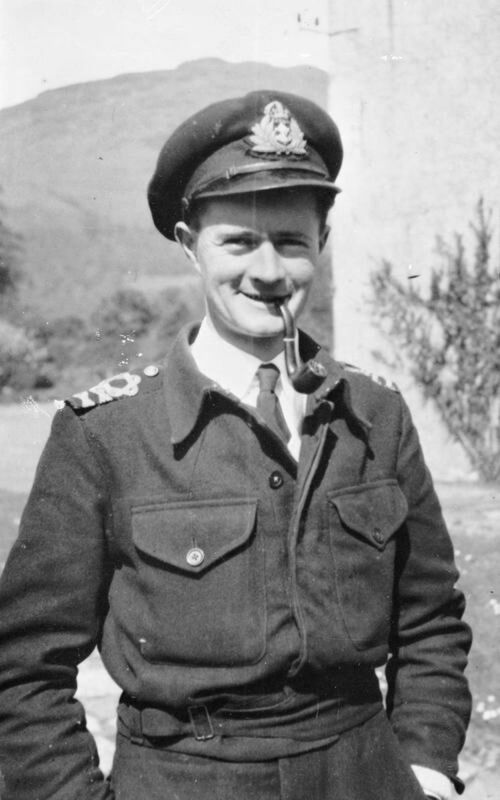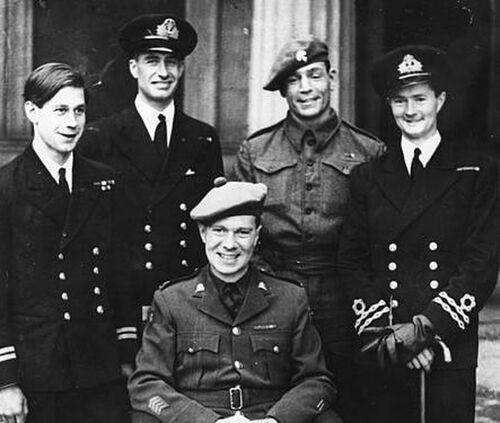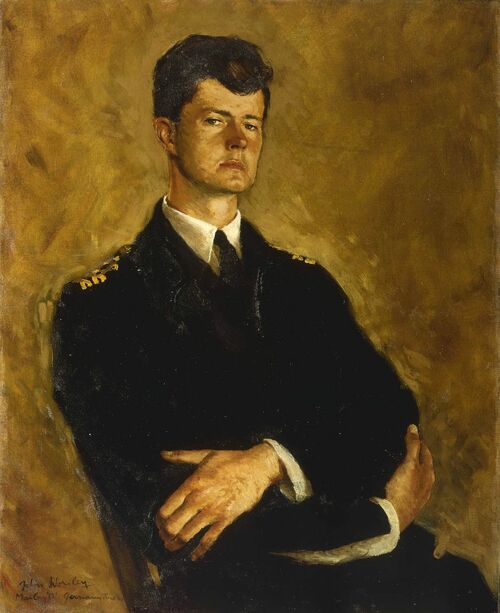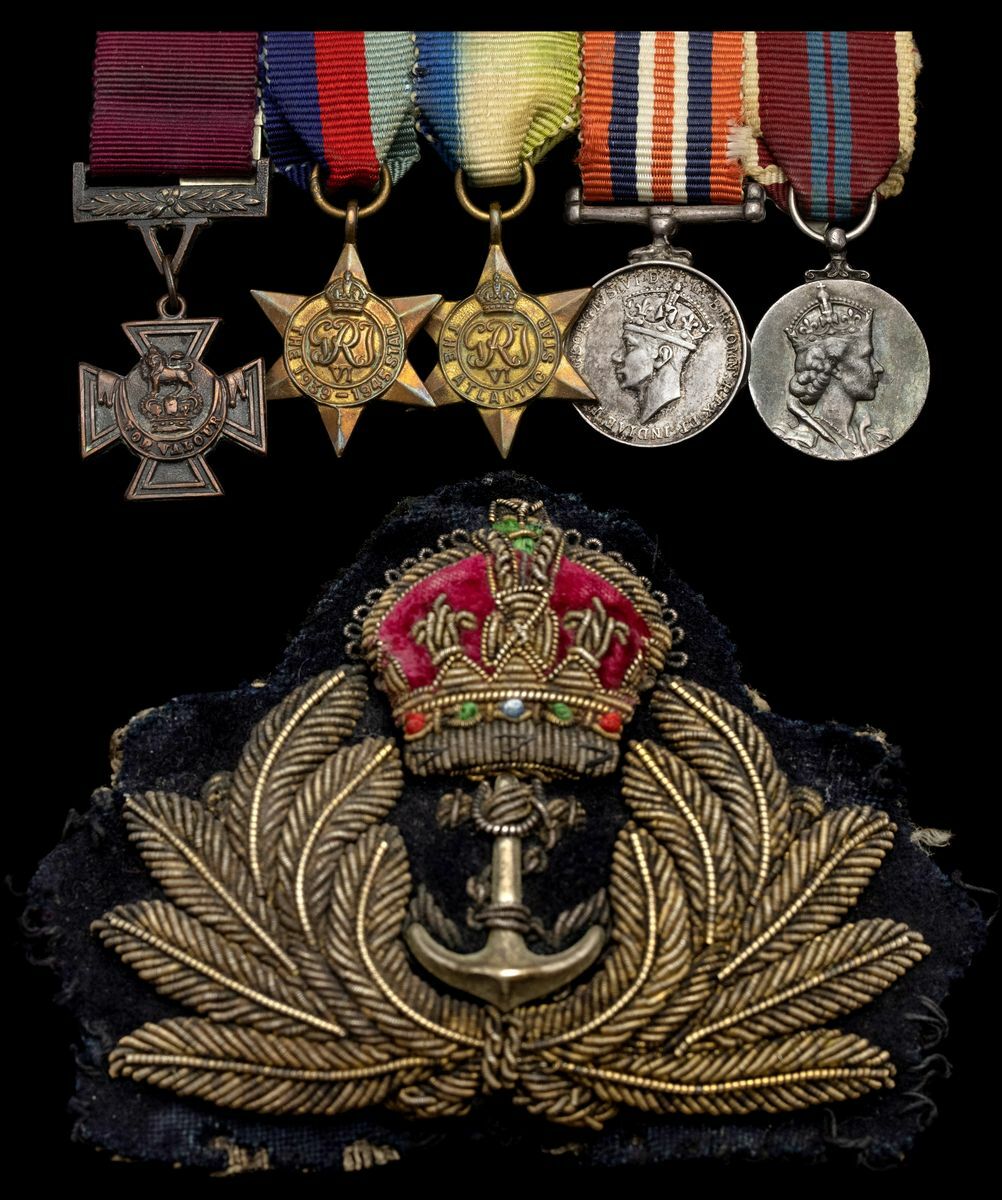Auction: 24112 - Orders, Decorations and Medals - e-Auction
Lot: 903
The mounted V.C. group of five miniature dress medals attributed to Commander D. Cameron, Royal Naval Reserve, decorated for the legendary attack upon the Tirpitz whilst she was in the Altafjord in September 1943, when navigating at least 1,000 miles from base in the Midget Submarine X6, negotiating a minefield, dodging nets, gun defences and enemy listening posts to deliver a crucial attack that put the Battleship out of action for months
Victoria Cross; 1939-45 Star; Atlantic Star; War Medal 1939-45; Coronation 1953, mounted for wear by Spink & Son, lacking retaining pin, good very fine (5)
[V.C.] London Gazette 22 February 1944, the official citation states:
'Lieutenant Basil Charles Godfrey Place, D.S.C., Royal Navy.
Lieutenant Donald Cameron, R.N.R.
Lieutenants Place and Cameron were the Commanding Officers of two of His Majesty's Midget Submarines X7 and X6 which on 22nd September 1943 carried out a most daring and successful attack on the German Battleship Tirpitz, moored in the protected anchorage of Kaafiord, North Norway.
To reach the anchorage necessitated the penetration of an enemy minefield and a passage of fifty miles up the fiord, known to be vigilantly patrolled by the enemy and to be guarded by nets, gun defences and listening posts, this after a passage of at least a thousand miles from base.
Having successfully eluded all these hazards and entered the fleet anchorage, Lieutenants Place and Cameron, with a complete disregard for danger, worked their small craft past the close anti-submarine and torpedo nets surrounding the Tirpitz, and from a position inside these nets, carried out a cool and determined attack.
Whilst they were still inside the nets a fierce enemy counter attack by guns and depth charges developed which made their withdrawal impossible. Lieutenants Place and Cameron therefore scuttled their craft to prevent them falling into the hands of the enemy. Before doing so they took every measure to ensure the safety of their crews, the majority of whom, together with themselves, were subsequently taken prisoner.
In the course of the operation these very small craft pressed home their attack to the full, in doing so accepting all the dangers inherent in such vessels and facing every possible hazard which ingenuity could devise for the protection in harbour of vitally important Capital Ships.
The courage, endurance and utter contempt for danger in the immediate face of the enemy shown by Lieutenants Place and Cameron during this determined and successful attack were supreme.'
Donald Cameron was born in Carluke in South Lanarkshire in Scotland on 18 March 1916. Joining the Merchant Navy at the age of seventeen he was also a member of the Royal Naval Reserve with the rank of Lieutenant on the outbreak of the Second World War.
Cameron was posted to H.M.S. Elfin at Blyth and joined the Sturgeon, part of the 6th Submarine Flotilla as Navigator on 15 November 1940. During his time with her she was patrolling off Norway but these sweeps proved to be uneventful.
Selected for Special Services in December 1941 Cameron was transferred to Midget Submarine service and joined the newly constructed X3. Transferring onto the books of Dolphin the next year he conducted trails with X3, the first of the midget subs actually constructed, the previous iterations having all been theoretical concepts.
Transferred again in late 1942 to the shore establishment Varbel in Scotland here Cameron was chosen to command X6. This vessel and five other x-craft left Loch Cairnbawn on 18 September 1943 for Operation Source, the attack upon Tirpitz. The midget subs had to be towed by larger vessels and were manned by 'Passage Crews' during this period, X6 was towed by Truculent however when they reached the operational area Cameron and his 'Operational Crew' were on their own.
Travelling fifty miles upriver through Kaafjord under the guns of the German defenders, dodging patrols and submarine nets X5, X6 and X7 reached Tirpitz. After making it passed the close torpedo and submarine nets the X6 and X7 dropped their charges beneath the warship, however as they did so they were detected. In the ensuing chaos it is unknown what happened to X5 commanded by Lieutenant Henty-Creer but it was likely destroyed by Tirpitz's guns before it could plant its charge.
The remaining midget subs were subject to heavy fire and couldn't escape, in spite of the barrage Cameron and Lieutenant Place of X7 ordered their machines scuttled, ensuring that their secrets would not fall into German hands before they escaped. The crews of these ships were taken prisoner however their mission had been a success, Tirpitz may not have sunk but she was badly damaged and consigned to the fjord where she would spend the rest of the war before her destruction by bombing in November 1944.
Of the six submarines which had left Scotland only three made it to the fjord and only two achieved their goal of planting charges, none escaped. The odds of completing the mission, which was the first of such attempted by the Royal Navy, were slim to none, despite this Cameron and Place succeeded not only in crippling the battleship but in rendering their craft unusable whilst under attack. For this remarkable feat both men were awarded the Victoria Cross.
Cameron was taken prisoner along with most of the crews of X6 and X7 and repatriated in May 1945. Seeing a series of post-war positions and commands with Stoic, Spiteful, Tiptoe and Trump he was promoted Commander in 1955. Posted to Dolphin Cameron's health deteriorated and he was admitted to the Royal Naval Hospital, Haslar in Gosport, dying there on 10 April 1961. His ashes were scattered from the conning tower of the submarine Thule three days later; sold together with copied research.
His full-size awards are held in the Lord Ashcroft Collection.
Subject to 20% VAT on Buyer’s Premium. For more information please view Terms and Conditions for Buyers.
Sold for
£4,000
Starting price
£800











